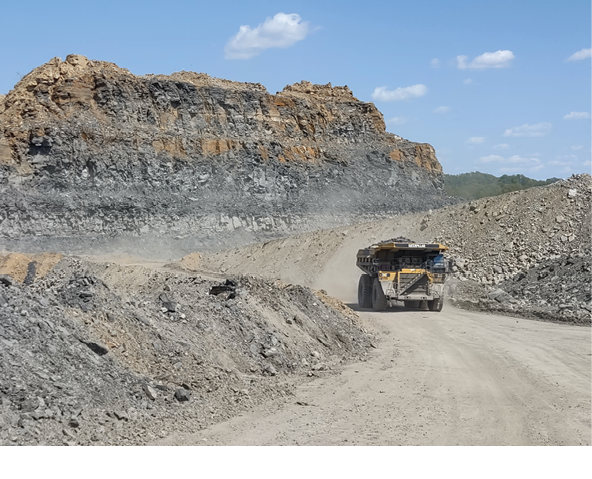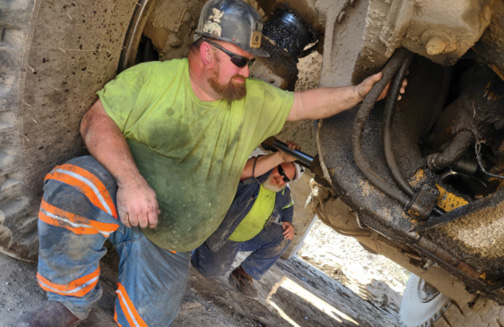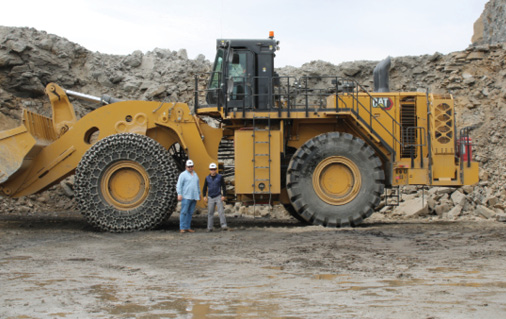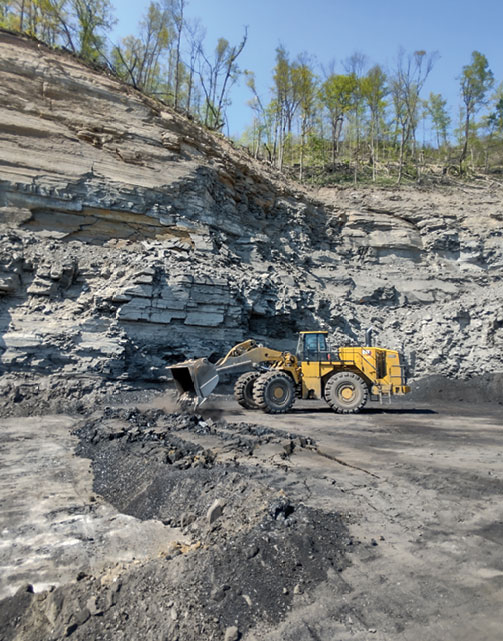Central Appalachian surface coal mines: they’re all the same, right? The crew at Clintwood JOD would beg to differ, especially as it relates to their Laurel Branch operation in remote Hurley, Virginia, that North American Mining magazine recently toured.
By Donna Schmidt

Surface coal operations dot the landscape in southern West Virginia, southwestern Virginia and eastern Kentucky. There are some standouts, however, in large part for exemplifying the way a mine should operate: safely, efficiently and with a keen eye on the safety and health of the individuals that keep it operating each day.
Many companies say their staff is family, but some things come in actions and not words. As the forthcoming pages will outline, those actions are commonplace for Clintwood JOD, which owns nearly two dozen properties in the region. One of its fastest-growing sites: Laurel Branch.
Controlled by Richmond Hill, Laurel Branch – tucked into the hills outside of Hurley, Va., extracts from the Splashdam, Hagy, Blair, Eagle and Clintwood seams along with three others. Mining started in October 2019 and, despite a bit of a slowdown during the pandemic, has not stopped since.
A running theme at Laurel Branch, along with safety and family, is setting itself apart from its neighbors – and even those outside of south-central Appalachia – by spotlighting what makes it unique and carrying that forward. It has absolutely made that happen. For example, the mine produces a metallurgical high-vol A product, though there is a nominal amount of thermal coal at the outcrops, and with a total of eight separate seams to pull from, its tonnage is distinctive.
With a longer mine life than a typical complex – about three to four decades, according to Clintwood JOD executives and minority owners Chris Adkins and Jordan Jones, and at least 10 at Laurel Branch – it and its sister mines have been a solid investment thus far to purchase the mine originally owned by TECO Coal from the now bankruptcy-defunct Cambrian Coal. The men, however, have taken that investment decision and gone, as the saying goes, all in. And they are going big.

Bringing Laurel Branch to life
According to Adkins, the Laurel Branch site post-purchase resembled somewhat of an equipment graveyard. It was, he said, the initial main challenge the mine had when Clintwood JOD took over the asset, but it was also what helped him and Jordan make the decision to turn the entire mine around.
“Equipment that had been parted out in effort to keep a skeleton spread of equipment running due to lack of funds,” he explained of the various disabled machines he and his staff had to evaluate once Laurel Branch was officially in its portfolio. From there, the company carefully inventoried and assessed what could be rehabbed, and what the associated cost reconciliation would be to bring some pieces back to life.
“By 2020 two fully functional spreads were running, and by 2021 three spreads were in place at Laurel Branch with a resident in-house Superior highwall mining machine.”
Here’s where the all-in part enters: in late 2021, Clintwood JOD ordered $10 million worth of new equipment, along with another $6 million in rebuilt/used fleet additions, all with the intent to start additional surface mines to ready themselves for a year-end 2022 goal to meet orders as demand for HVA coal continues to rise.
There was a hiccup in that plan, the pair explained. Caterpillar-promised delivery dates for December 2021 on its orders fell until May 2022, which caused delays in startup of the planned new jobs, resulting in a stinging $14 million dollar shortfall of revenue as a result of the delay. In addition, the OEM cited parts shortages and Covid/labor challenges, which added additional hardships.
That situation has since been rectified, with the machines put into immediate action once delivered, and Adkins noted that every fleet addition has been running as advertised thus far. The star of its fleet is the most recent arrival to the site, the second of two Cat 992 loaders (also in its order: a new D11 and three new 988s). Laurel Branch’s three equipment spreads include one 993 spread and two new 992 spreads, and Clintwood will double down once again with $10 million in additional equipment in 2022 for its six total fleet spreads. Komatsu and Hitachi are also prevalent badges on-site.
The proof of money well spent is in the numbers for this mine, with availability spiking from the low 70% range before the additions, to a 93% availability that is on its way upward.
“In today’s market, it doesn’t take long to pay new equipment off. With increased labor, fuel, and explosive cost, you can’t afford to have a low availability of equipment. I thought the market would turn, and we got the jump on ordering equipment thanks to J.R. Coleman and the Boyd Cat crew. We had some issues, but they came through in the end,” Adkins said.
Preparation
Coal is processed at the Clintwood JOD No. 3 plant near Hurley with a 650-ton-per-hour dual circuit facility with column flotation. It manages the needs of Laurel Branch and its surrounding sister mines.
According to management, 100% of the coal from this site is currently required to be trucked to the No. 3 preparation plant near the operation. Its near-term plans are to install a belt system with a glory hole, which it said will help alleviate the trucking issues and associated costs, currently higher due to fuel and time resources.
About 20% of Laurel Branch’s coal is sold domestically; the remaining 80% is shipped to customers in China, India, Turkey and Brazil. Ninety percent of tonnage from the mine is shipped to HVA customers to make a superior coking product for steel use.
“Coal from this complex has very little variability, [a factor] required by coking facilities,” the owners said.
The fruit of Laurel Branch
As surface mines lifespans can often fly by, this mine is just hitting its stride in in its estimated long life. With low operating costs and nearby preparation facilities to its benefit, it still has 18 million tons of recoverable deep coal. All told, the company has 37 Mt permitted (67 Mt total), and is heading toward a year-end 2022 goal of 87 Mt across its ops sheet. In the short-term, Clintwood JOD is targeting 1.5 Mt for whole-year 2022 and has its sights set on exceeding 2.3 Mt next year.
Geology is, with little exception, very good. Adkins noted it is normal for the region, with some second mining in areas that had been left largely untouched since the 1970s.
“Few mines in central Appalachia boast the reserves and lifetime that Laurel Branch still has,” Adkins pointed out, adding it is poised for continued success. “This gem offers the best of the best in the HVA market.
With millions of tons coal sitting beneath the majestic area, it only adds in the blending and marketability of this facility. Our clean tons per foot is lower than that in West Virginia that I am used to, which forces us to be more efficient and cost-conscious to compete.”
Laurel Branch at this time produces about 60,000 clean tons monthly, with an increase as mentioned in 2023. Surface Mine Manager Tom Miekle, formally of Massey Energy like Adkins, has recently kicked off that tall task with a surface mine improvement program for JOD.
Said Adkins: “With of 35 years of experience, he will be bringing added value to superintendent Gene Boyd and his management team. Machinery movements and load rate counts are key parts to the new tracking system utilized on equipment at Laurel Branch. You can’t manage what you can’t measure, and we measure everything.”
Overall design changes for that plan are being implemented by Clintwood General Manager Chris Stanley along with Boyd, Mielke and mine planner Tim Tackett to increase the recoverable tons and improve the yards moved by equipment. Utilizing Nelson Brothers as the blasting contractor, more rock is moved via cast blasting than previously; management has noted that the biggest upside to this effort has been its ability to continuously tweak the layout and cast.

Laurel Branch’s seven mechanics keep the fleet humming. 
Adkins and Jones with Laurel Branch’s newly delivered Cat 992.
Challenges and opportunities
As with many of its contemporaries in the region and the country, fuel costs this year have also been on the rise – an increase of 66% for Clintwood. Along with a 200% jump in many parts costs and a 19% increase in explosive costs, and it puts into perspective how big of an achievement it has been for JOD to remain in line with its cost effectiveness at Laurel Branch and all of its mines.
“Hiring of a full-time on-site tire man and tire truck has helped in the overall tire usage of the trucks,” Adkins said. “Proper air pressure and changes put in place have limited the increase in tire cost via lower usage than that of before. I mean, when you think about it, most of our automobiles have tire pressure blue-toothed to a readout in your dash, yet our million-dollar trucks don’t. It’s ludicrous. We are searching for sensors now to help us in this area.”
The mine’s most significant obstacle at current is supply chain-related, namely the timely delivery of equipment parts. Both noted that it appears many distributors are struggling to keep replacement parts, even engines and transmissions on the shelf, a common theme among suppliers and operators alike in more recent times. However, that does not seem to be the case for its longer-term planning efforts, as some hurdles in its increase spread program are now lessening and becoming less sensitive.
Adkins and Jones stress the supply chain issue has extended beyond consumables and equipment parts to transportation, at least recently, with a shortage of trucks and trucking companies. The mine is, however, keeping coal moving at the site with tandem trucking off of “the hill” at Laurel Branch to the plant just three miles away. Looking ahead, Adkins said it is planning a conveyance system with a glory hole into a deep mine, a move that will not only boost efficiency but also bring sizable savings to its transportation budgets.
Maintenance
An inherent issue with taking over a mine that has left an aging fleet in varying levels of disrepair is maintenance, but Laurel Branch’s staff has worked tirelessly to turn it around. Equipment is now maintained via the respective OEMs, and monitoring is being performed consistently; for example, oil samples are regularly pulled and evaluated on every item of equipment.
The executives applaud the talented maintenance group at Laurel Branch, and all of its operations, who have complete authority to stop and down the equipment at any time to fix issues. Its seven mechanics, each with their own helper, keep the fleet humming.
“This is even as we bring new equipment to life,” Adkins said. “They are the most talented group of mechanics I have ever been around.”
Maintenance of equipment is monitored by Clintwood JOD Maintenance Manager Scott Harden, who said the real brains of the bunch are lead mechanics Jeremy Moses, “Rambo” and “Lead”: “They never fail to figure out and fix a complicated issue and are great guys to work with.”
The growth of Laurel Branch
It is here where the theme of family really is evident. While Laurel Branch’s crews are hard-working and skilled, they are given the trust and freedom to take the mine forward with minimal limitation.
Jones, a minority owner, frequents the job and has plans to increase the amount of new equipment purchased even further. “These guys know how to do their jobs but have been hamstrung by the lack of equipment availability. In the past year we have been able to make a positive change for them with new equipment and a lot of rebuilds.
“Give these guys tools to work with, and then get out of their way.”
He called the mine’s crew safe, but also a group that achieves results. “It is great to come for a visit and see the new equipment in use and see the increase in production as a result. I think we have a great future here.”

Power of people, and family
Adkins echoed Jones, adding that its people are the key to its success and its future. With the recent addition of Billy McCoy and Meikle, it now has solidified a top-notch management group that can sustain operations long-term and put plans in place for continuous growth.
“We have one of the better management groups in the industry, and especially this area,” he said.
“We have a pretty much flatline hierarchy and operate as a team; we have adopted the ‘key member’ principles we used in Massey, where each group operates as their own company. Chris Stewart, Gene [Boyd], Homer [Sullivan] and Chuck [Cornett] operate companies inside of a company, and they are CEOs of their group. They are responsible for their own $60 million groups that know their own costs and control their paths forward.”
This idea was cemented in Adkins’ mind, he said, as he himself gained experience in mining.
“My mentor cautioned me a long time ago that one person can’t out work 250. It took me a long time in this industry to realize that, but it’s true. Hold people accountable, but don’t put shackles and handcuffs on them if you expect them to do their jobs.”
Currently, Clintwood JOD employs 256, and 78 of those call Laurel Branch their home mine. Staffing is 100% company employees with a few welding contractors assisting. As of June 1, Laurel Branch had not marked a lost-time incident (LTI) for more than two years.
As for its formal safety initiative, the mine participates in the Safety is Priority 1 program, a movement that makes everyone a safety director, said Jones and Adkins.
“They are able to shut down any piece of equipment at any time, for any reason and not feel any retaliation nor questioning,” Jones said. Adkins added: “If you want a safe company, everybody has to be empowered.
“Everybody has to be able to voice their opinion and feel like they have some ownership. We encourage our members to say something if they see somebody doing something that might get them hurt – even if it’s me.”
With that kind of empowerment, and very little turnover, it makes sense that the family theme is resounding. Adkins revealed as much in his comments on the safety of those at Clintwood’s mines.
“The last thing we want is for somebody to do something that could lead to injury and, heaven forbid, that someone didn’t say something. Our members are like family; most have been here since I have or before. Our best safety ideas come from them – not to say we don’t have a top-notch safety group in [supervisors] Benny and Dennis Akers, it’s just that our safety department knows how to get members involved with the culture change in a positive way.”
Both are proud to highlight the company’s efforts to hire local. In fact, most of its staff live within 45 minutes of the site.
“Employees at Laurel Branch have found a place to work that has longevity,” Jones said. “They are able to plan on working at one place for a long period of time without the fear of the mine running out of reserve, and now that they see new iron rolling up the hill, they have a job that is more enjoyable as well.
“The job looks completely different today, is safe and well run, which is a testament to the JOD workforce, and [this] job has become a workhorse mine.”
What does JOD mean?
One of the most asked questions of the team at Clintwood JOD: just what does JOD mean? The answer is a nod not only to history, but also to the loyalty to each other that this company exemplifies.
The phrase “Join, or Die” heralds back to Benjamin Franklin, who in 1754 during the French and Indian War created a political cartoon that was a commentary on the lack of loyalty and unity shared by the original 13 colonies and was a call to encourage them to come together for a common goal of independence.
The symbol is a snake cut into eight sections, each with a region attached: South Carolina, North Carolina, Virginia, Massachusetts, New Jersey, New York, New England and Pennsylvania (Delaware was part of Pennsylvania at the time, and New England was represented as one segment in the depiction; Georgia was entirely omitted). It later would become a symbol of freedom during the American Revolutionary War.
At the heart of it: how crucial it was to have unity. Fast forward nearly 250 years, and it represents a core mission for its eponym, the hundreds making up the circle of pride at Clintwood.
“We were composed of multiple company personnel with different philosophies and ideas. If we didn’t abandon the philosophy of ‘this is how we used to do it’ we wouldn’t succeed,” Adkins said.
“Likewise, as a coal industry … if we all continue to try to put each other out of business and not support one another … we would all continue to go bankrupt. It’s time to support one another. Join or die … not simply exist.”
